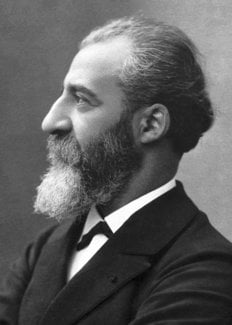Henri Moissan
Biographical

Henri Moissan was born in Paris on September 28, 1852. His advanced education began in the Collège de Meaux and later in Edmond Frémy’s laboratory at the Musée d’Histoire Naturelle, where he attended lectures by E.H. Sainte-Claire Deville and Henri Debray. A year later, he removed to Dehérain’s laboratory in the École Pratique des Haute Études and subsequently he directed a small laboratory of his own before joining Debray and Troost in the laboratories of the Sorbonne. He was appointed to a junior position in the Agronomic Institute in 1879 and he gained his doctoral degree in 1880 with a thesis on the cyanogen series. He became assistant lecturer and senior demonstrator at the School of Pharmacy and in 1886 he was elected Professor of Toxicology. In 1899 he took the Chair of Inorganic Chemistry and in 1900 he was appointed Assessor to the Director of that School. In the same year, he succeeded Troost as Professor of Inorganic Chemistry, University of Paris.
Moissan’s first researches concerned the interchange of oxygen and carbon dioxide in the leaves of plants. He was soon to leave biology for the field of inorganic chemistry, where his early work was on the oxides of iron-group metals and chromium and a study of the chromous salts. In 1884 he turned his attention to fluorine chemistry, preparing some organic and phosphorus derivatives of that element. The following year he discovered that solutions of potassium fluoride in hydrogen fluoride at certain strengths remained liquid and conducted electrolytically at sub-zero temperatures: a year later he successfully electrolysed these solutions to isolate fluorine for the first time. He made a full study of the properties of the gas and its reactions with other elements.
In 1892, Moissan theorized that diamonds could be synthesized by crystallizing carbon under pressure from molten iron. He designed and developed the electric-arc furnace, attaining temperatures up to 3,500°C, to assist him in work which led to the production of tiny artificial stones. He subsequently used the furnace to volatilize many substances which had been regarded as infusible and to prepare many new compounds, particularly carbides, silicides and borides; in 1891 he discovered carborundum. His close study of the carbides and their reaction with water led to his theory that, in some cases, petroleum may be formed by subterraneous reaction between certain carbides and water. He prepared the hydrides of calcium, sodium and potassium and showed them to be non-conductive and, using the electric furnace, isolated many metals.
Moissan is credited with over three hundred publications, his greatest works being Le Four Électrique (The electric-arc furnace) (1897), Le Fluor et ses Composés (Fluorine and its compounds) (1900) and Traité de Chimie Minerale (Treatise on inorganic chemistry) (five volumes 1904-1906). He was an excellent lecturer and a meticulous and patient experimentalist.
Moissan, a Commandeur de la Légion d’Honneur, was elected member of the Académie de Médecine (1888), Académie des Sciences (1891), Conseil d’Hygiène de la Seine (1895 ), and the Comité Consultatif des Arts et Manufactures (1898). In 1887 he was awarded the Prix Lacaze; he was Davy medallist in 1896 and Hofmann medallist in 1903. He was honoured by the Franklin Institute of Philadelphia and awarded Fellowships of the Royal Society of London and The Chemical Society (London). He held honorary memberships of many other learned societies.
He died suddenly in Paris on February 20, 1907, shortly after his return from the prize-giving ceremony in Stockholm.
This autobiography/biography was written at the time of the award and first published in the book series Les Prix Nobel. It was later edited and republished in Nobel Lectures. To cite this document, always state the source as shown above.
The Nobel Foundation's copyright has expired.Nobel Prizes and laureates
Six prizes were awarded for achievements that have conferred the greatest benefit to humankind. The 12 laureates' work and discoveries range from proteins' structures and machine learning to fighting for a world free of nuclear weapons.
See them all presented here.
